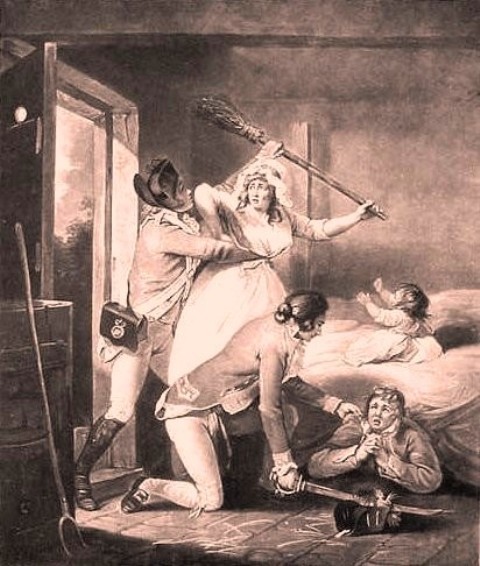

Recruit Deserted, 1791 print from an engraving by George Keating (1762-1842)
After a painting by George Moreland (1763-1804)
*Trial transcripts offered through the links below are in PDF format*
Courts-martial were a necessary component of 18th-century British army operations. Officers and men could be subject to a court-martial for a variety of offenses, most of which were printed in the official regulatory volume Rules and Articles for the Better Government of his Majesty's Horse and Foot Guards, and all other his Majesty's Forces in Great Britain and Ireland, Dominions beyond the Seas, and Foreign Parts. Army and regimental/battalion commanders also had leverage to add to the list “All Crimes not Capital, and all Disorders and Neglects, which Officers and Soldiers may be guilty of, to the Prejudice of good Order and Military Discipline” via general, garrison, divisional, brigade, or regimental orders.
Although the Articles of War were supposed to “be read and published Once in every Two Months, at the Head of every Regiment, Troop, or Company, mustered, or to be mustered” it does not appear to have been a rule perfectly followed. British regimental-level orderly books from the period record orders for the reading of the Articles, although not every two months. One must wonder how exactly the articles were to be “duly observed and exactly obeyed by all Officers and Soldiers who are or shall be in Our Service” if they were not regularly read to the troops as ordered in the articles themselves.
General officers were not immune to courts-martial—even the colonel of a regiment could be brought to trial by legitimate accusations made by the men of his regiment. In the case of the original colonel of the 62nd Regiment, Lieutenant-General William Strode (ca.1698-14 January 1776), his May 1772 trial was forced by the claims from a collective of 90 men and boys of the regiment for “having [been] Wronged…[by their colonel due to his] withholding from them the Cloathing, to which they were intitled for the year 1769, the Cloathing which appeared to have been delivered to them in the said year 1769 upon their arrival in Ireland from the West Indies being no other than that which was of Right due them for the year preceding….” The court-martial of Lieutenant-General William Strode is lengthy and complex, and provides a fascinating insight into the multi layered, behind-the-scenes management (and mismanagement) of the 62nd Regiment in the late 1760s-early 1770s.
There were three types of courts-martial used in Lieutenant-General John Burgoyne's Army from Canada during the course of the Northern Campaign of 1777: general/army, garrison/brigade, and regimental/battalion. The nature of the offense determined the level of the trial, with capital crimes reserved for the highest (general/army) level. Unfortunately, the number of trials which took place in Burgoyne's army in 1777 is incalculable because very few garrison/brigade and regimental/battalion-level orderly books survive; only in those records would one find the listings of the trials at those respective levels. In one of the few regimental orderly books to survive from the campaign (47th Regiment), regimental courts-martial took place as often as a few times a month. It is unfortunate that minutes of regimental courts-martial went unrecorded.
At the army level, general courts-martial are better documented as trial occurrences, names of and charges against the accused, as well as trial outcomes, were recorded in the general orders of the army. Also, due to the severity of the crimes, the minutes of these trials were recorded. In the case of Lieutenant-General Burgoyne's Army from Canada in 1777, there were three principle officers who were routinely involved with all British general courts-martial proceedings:
Lieutenant-General John Burgoyne, commander of the army—Burgoyne alone had the authority to issue warrants to put general courts-martial into motion. He also had to confirm the findings of the court, and if applicable, set the time and place for punishment.
Captain James Henry Craig, 47th Regiment, Deputy Judge Advocate—Craig was the highest authority on judiciary affairs in Burgoyne's army. As the head judge advocate of Burgoyne's army, Craig was entrusted with gathering evidence against and prosecuting the accused. In Craig's absence, an acting deputy judge advocate would be appointed.
Lieutenant Phineas Atherton, King's Royal Regiment of New York, Provost—Atherton was one of the few non-British officers entrusted with army-level staff duty. His position of provost made him a sort of police chief of the camp. He was assigned a guard of two sergeants (one British, one German), and 20 men (10 British, 10 German) at all times; this guard was supposed to rotate its personnel once every two weeks.
Despite all the trials which took place in Burgoyne's army, there are only three period transcripts of British courts-martial from the Northern Campaign of 1777 known to exist:
The Court-martial of Private Patrick McDonald, 47th Regiment. McDonald was accused of desertion after finishing work in the officers' mess. Trial dated the camp at William Duer's house (near Fort Miller), New York, 24 August 1777.
The Court-martial of Private Georg Hundertmark, 9th Regiment. A German von Scheither recruit serving in the British army, Hundertmark was accused of deserting with arms and accoutrements while posted as sentinel. This very compelling trial is dated the camp at William Duer's house (near Fort Miller), New York, 24 August 1777.
The Court-martial of Private Patrick Shehan, 62nd Regiment, may be the most bizarre desertion trial in the British army from the entire war. Drafted from the 11th Regiment and put into the 62nd Regiment in February 1776, Shehan deserted his new corps before it sailed from Ireland April. Nevertheless, Shehan was captured well over a year later skulking about Burgoyne's British light infantry camp! Trial dated the camp at William Duer's house (near Fort Miller), New York, 9 September 1777.